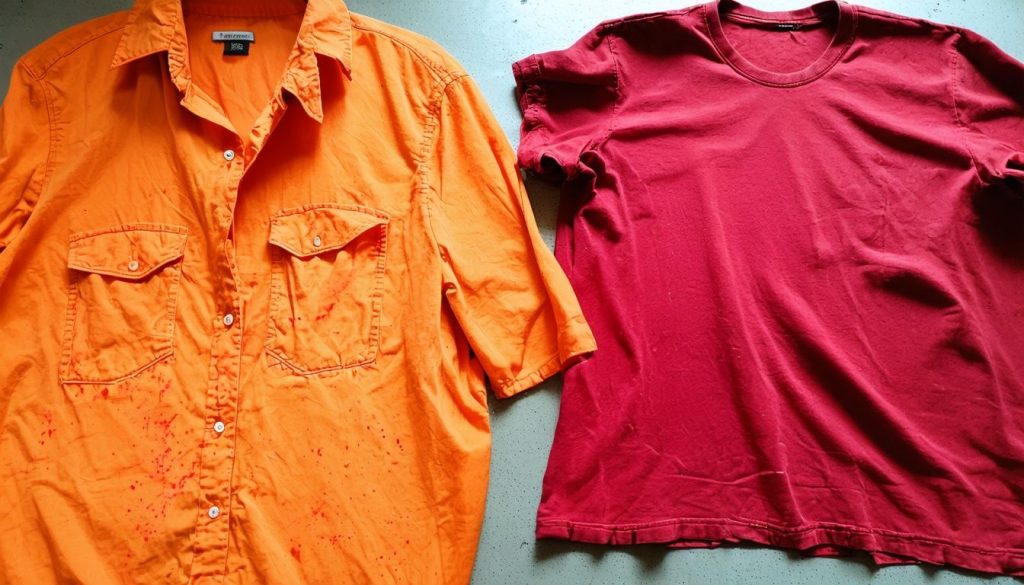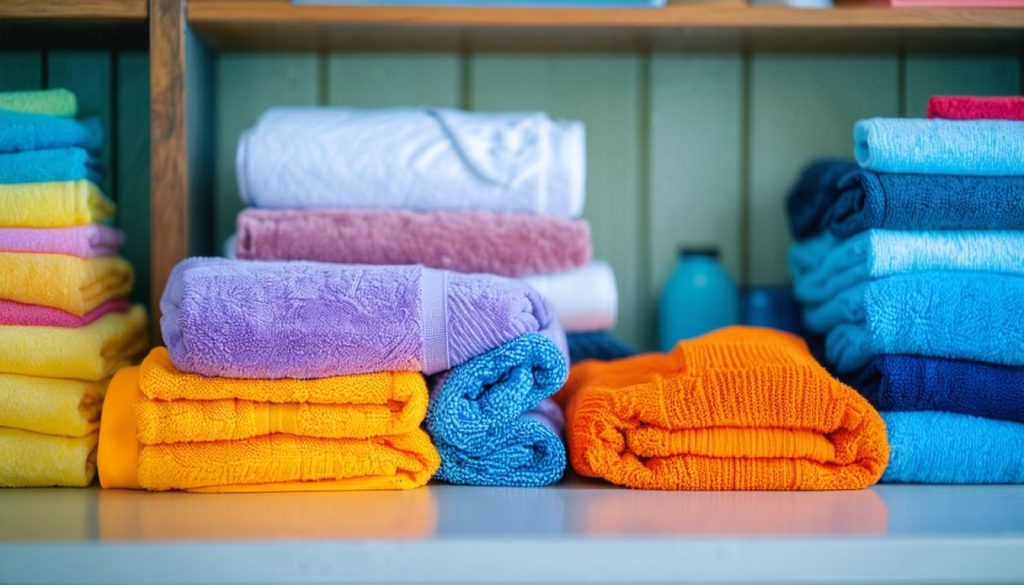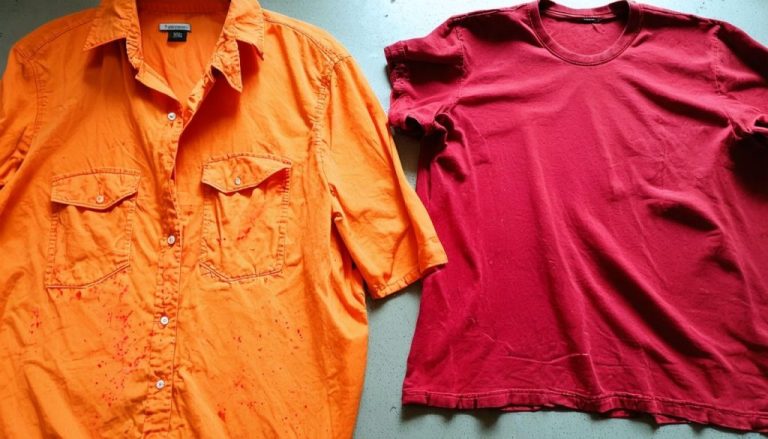Worried about your vibrant reds and oranges turning your favorite white shirt into a pastel nightmare? Fear not, as these expert tips will help you keep your clothes looking as fresh and bright as the day you bought them. For unique apparel that stands the test of time, explore InktasticMerch for quality garments that are both stylish and durable.
Have you ever opened your washing machine only to find that your white garments have turned a shade of pink? It’s a common annoyance known as color bleeding. Reds and oranges are notorious for this issue, playing havoc with your wardrobe. In this article, you’ll discover practical strategies to avoid color bleeding, ensuring your clothes remain vibrant and pristine. Get ready to master the art of a color-safe laundry day!
Key Takeaways
- Sort your laundry by both color and fabric type to prevent dye transfer.
- Opt for cold water washes to maintain the integrity of fabric fibers and lock in dye molecules.
- Utilize color-catcher sheets to capture stray dyes before they settle onto other fabrics.
- Add 1/2 cup of white vinegar or a tablespoon of salt to your wash cycle to help set colors and curb bleeding.
- Check new garments for colorfastness by dampening a discrete area and testing with a white cloth before laundering.
Why Do Colored or Dark Clothes Bleed?

Color bleeding occurs when loose dyes in fabrics are released during washing, exacerbated by water and the mechanical action of the machine.
Fabric Types and Dyes
| Fabric Type | Susceptibility to Bleeding | Notes |
|---|---|---|
| Synthetic (polyester, nylon) | Less prone | High-quality dyes show greater stability |
| Natural (cotton, wool) | More prone | Often involve less stable, cheaper dyes |
| Red and orange dyes | Highly susceptible | Especially challenging |
Fabric composition and the type of dyes used can significantly influence color bleeding. Synthetics like polyester and nylon generally resist bleeding better than natural fabrics. Poor dyeing practices and inferior dyes often result in color transfer during washing.
Red and orange dyes are particularly notorious for bleeding issues.
Opting for synthetics labeled as colorfast helps mitigate the risk of dye transfer.
Good dyeing practices using superior dyes play a key role in preventing color bleeding. However, overzealous dyeing methods by some manufacturers might exacerbate the problem. To reduce the chances of dye transfer, choose clothing advertised as colorfast.
Washing Methods
Proper washing techniques are essential in curbing color bleeding. Cold water washing effectively keeps fabric fibers closed, thereby limiting dye leakage during laundering.
Besides preserving color, this method conserves energy, making it an efficient choice.
Organizing your laundry by color and fabric type provides added protection against bleeding. Grouping similar shades together minimizes unwanted dye transfer. Opting for the appropriate washing machine cycle adds another layer of garment protection.
Gentle cycles with reduced durations reduce fiber agitation, helping to maintain the original color of your garments. The following section delves into more specific advice on preventing color bleeding.
Tips for Preventing Color Bleeding

Keeping your laundry free of color bleeding is simpler than it seems. Try these straightforward techniques to ensure your clothes stay beautifully vibrant.
vibrant and fresh.
Sort by Color and Fabric Type
| Sorting Guidelines | Benefits |
|---|---|
| Separate Light from Dark | Reduces Dye Transfer |
| Group Similar Fabrics | Avoids Damage and Maintains Color |
| Whites | Launder Separately |
| Dark Clothes (Jeans, Black T-Shirts) | Wash Together |
Sorting your laundry by shade and fabric kind is vital in averting color bleeding. This essential practice involves dividing light garments from dark ones while categorizing similar materials.
Proper sorting significantly decreases the likelihood of colors transferring between clothes during washing. Whites should be cleaned individually, whereas darker items like jeans and black shirts can be washed as a group.
Taking care of fabric is crucial to preserving color brightness. Various materials need distinct washing approaches to uphold their quality and avert color loss. Delicate fabrics such as silk or wool require careful attention, unlike robust cotton that can endure a more intense wash.
The subsequent action in preventing color bleeding is choosing the right water temperature for your organized laundry loads.
Preparing your laundry properly is crucial to maintaining clothing colors and extending their lifespan.
Wash in Cold Water
Once your laundry is sorted, consider the water temperature for washing. Using cold water is highly effective in preventing colors from bleeding, as it helps keep fibers intact, locking the dye molecules inside.
Cold water washing not only protects garment colors but also enhances energy efficiency. Many modern detergents are designed to work well in cold conditions, effectively cleaning without risking dye loss.
Using cold water for laundry helps preserve fabric quality and extends the life of beloved garments. This straightforward yet impactful method is fundamental to adequate fabric care and color safeguarding.
Use Color-Catcher Sheets
Color-catcher sheets revolutionize the prevention of color transfer in laundry. These commercially available “dye magnets” capture free dyes in the wash before they can affect other items.
Particularly effective against challenging red and orange dyes, simply insert a sheet into your wash to protect cherished clothing from unwanted color transference.
Employing color-catcher sheets is a part of maintaining color-safe laundry habits, with the next suggestion involving the use of vinegar or salt for enhanced dye protection.
Incorporate Vinegar or Salt
Vinegar and salt serve as robust aids against color bleeding while laundering. Distilled white vinegar, due to its acidic properties, locks in dyes and naturally softens fabrics as well.
Adding ½ cup of white vinegar to your rinse cycle can help maintain vivid colors and shield your clothing. Salt plays a similar role in color retention—try integrating a tablespoon of it into your wash for better dye adherence.
These simple household items can considerably uplift your laundry care regimen, with apple cider vinegar offering a viable alternative to white vinegar for similar fabric preservation benefits.
By adopting these strategies, you’ll defend your clothes’ vibrant shades and increase their longevity.
Test for Colorfastness
Conducting a colorfastness test prevents undesirable dye transfer during washing. This straightforward task entails wetting a hidden part of the garment and rubbing it with a white cloth.
If color transfers onto the cloth, there’s a chance the garment might bleed during the wash. Garment care labels
Often, fabric labels provide crucial details about a textile’s resistance to color fading.
If an item fails this test of color retention, various techniques can be implemented to maintain its vibrancy. These strategies include washing the item separately or with similar shades, utilizing cold water, and incorporating color-catcher sheets into the laundry cycle.
How to Address Color Bleeding Incidents

Even with precautions, color bleeding can occur. If you discover dye transfer on your garments after a wash, here’s how to address it effectively.
Separate and Individually Rewash
At the first sign of color bleeding, swiftly remove the affected garments from the load. Rewash each item individually using cold water and a detergent safe for colors, aiming to eliminate excess dye and avert additional staining.
If dye proves persistent, soak the clothing in warm water mixed with oxygen-based bleach prior to rewashing.
Red garments are particularly prone to bleeding; therefore, it’s advisable to wash them separately in cold water during the initial washes. Adding vinegar to the final rinse can help stabilize colors and curb bleeding.
Employ Effective Stain-Removal Techniques
Once you’ve separated and rewashing the affected garments, various stain-removal techniques can address any remaining color bleeding. Oxygen bleach is especially adept at removing unwanted color stains.
Dissolve oxygen bleach in hot water, allow it to cool, then immerse the garment for 15 minutes before rinsing. For white clothing, baking soda is an excellent option due to its natural whitening abilities.
White vinegar offers significant benefits for tackling color-stained fabrics. Add half a cup during the final rinse to leave garments looking clean and bright. A mix of vinegar and baking powder can also efficiently eradicate color stains from dryer drums, preventing future loads from being compromised.
Conclusion
Maintaining color vibrancy in your laundry is achievable with ease. By utilizing these straightforward strategies—sorting, opting for cold water, and using color-catchers—you can protect the brilliant hues of your garments.
Testing new items for colorfastness before combining them with other clothes is wise. By adhering to these procedures, you’ll preserve your treasured clothing’s longevity and avoid the hassle of damaged laundry.
FAQs
1. How can I prevent color bleeding in the wash?
Organize laundry by colors, use cold water, incorporate vinegar into the rinse cycle, and try employing color-catching sheets.
2. What triggers color bleeding in clothing?
Factors like hot water, strong detergents, and overfilled loads can lead to dye bleeding. New clothes are particularly susceptible.
3. Is it advisable to wash dark and light clothing together?
It’s advisable to avoid mixing them. Segregating dark from light clothing prevents dye transfer and helps maintain their fresh appearance.
4. How can I rectify clothes that have already bled?
Consider soaking them in oxygen-based bleach. Use a color remover for whites, although some stains may be permanent.




